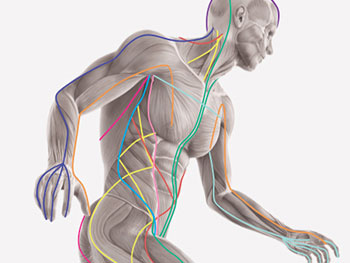Back
Understanding Anatomy Trains and Myofascial Connections
By Dr. Christine Martirez PT, DPT on 3/25/2024

Within the intricate web of the human body lies a network of myofascial connections known as Anatomy Trains. These interconnected pathways offer a holistic view of movement anatomy, highlighting the vital role of fascia in supporting and coordinating muscular function. In this blog post, we'll delve into the world of Anatomy Trains, explore the significance of fascia for the neuromuscular system, and discuss how understanding these connections can enhance pelvic floor physical therapy.
Understanding Fascia: The Body's Architectural Matrix
What is Fascia?
Fascia is a three-dimensional web of connective tissue that surrounds and interconnects muscles, bones, organs, and nerves throughout the body. It provides structural support, facilitates movement, and serves as a conduit for communication within the body.Functions of Fascia:
Fascia plays a multifaceted role in the neuromuscular system, including:Providing structural integrity and support for muscles and organs.
Transmitting mechanical forces and distributing tension throughout the body.
Facilitating proprioception, allowing for awareness of body position and movement.
Participating in fluid exchange and immune response.

Anatomy Trains: Mapping Myofascial Connections
Back Functional Line:
The Back Functional Line connects the latissimus dorsi and the gluteus maximus through the thoracolumbar fascia. It plays a crucial role in decelerating internal rotation of the femur during ground impact, contributing to stability and efficient movement.Functional Front Line:
The Functional Front Line, also known as the Anterior Oblique Sling, connects the external oblique, anterior abdominal fascia, and contralateral adductors. This sling system provides stability and support during movements such as walking, running, and rotational activities.Superficial Back Line:
The Superficial Back Line connects the peroneals, biceps femoris, thoracolumbar fascia, and erector spinae. It supports upright posture, spinal extension, and efficient movement of the lower extremities.Lateral Line:
The Lateral Line connects the gluteus medius and minimus, tensor fascia latae, and lateral spinal stabilizers. It plays a crucial role in hip stability, pelvic alignment, and lateral movement patterns.
Utilizing Myofascial Connections in Pelvic Floor Physical Therapy
Assessment and Treatment:
Understanding Anatomy Trains allows pelvic floor physical therapists to assess and address myofascial imbalances that may contribute to pelvic floor dysfunction. By evaluating the integrity and function of these myofascial connections, therapists can develop targeted treatment plans to restore balance and function.Integration of Movement Patterns:
Pelvic floor physical therapy incorporates functional movement patterns that engage multiple Anatomy Trains simultaneously. By integrating movements that activate the back functional line, functional front line, superficial back line, and lateral line, therapists promote coordinated and efficient movement patterns.Mind-Body Connection:
Myofascial release techniques and mindful movement practices enhance the mind-body connection, allowing individuals to cultivate awareness of their body's movement patterns and sensations. This integration fosters greater proprioception and facilitates optimal pelvic floor function.
Harnessing the Power of Myofascial Connections
Anatomy Trains offer a holistic perspective on movement anatomy, highlighting the intricate connections within the body's myofascial network. By understanding and utilizing these connections in pelvic floor physical therapy, practitioners can enhance treatment outcomes and empower individuals to achieve optimal pelvic health and function. Through targeted assessment, personalized treatment plans, and integration of movement patterns, pelvic floor physical therapy becomes a transformative journey towards balance, strength, and vitality. Embrace the wisdom of Anatomy Trains, and embark on a path towards greater harmony and well-being within the body's architectural matrix.
If you have questions or concerns regarding your pelvic floor, please reach out to us at Pelvic Health Center in Madison, NJ to set up an evaluation and treatment! Feel free to call us at 908-443-9880 or email us at receptionmadison@pelvichealthnj.com.
Read More:
How Chronic Pelvic Congestion in Men Contributes to Prostatitis By Shannon Strauch, PTA, STMT-1 on 12/11/2024 How lymphatic issues can cause symptoms of prostatitis Prostatitis and Tight Pelvic Floor Muscles: A Comprehensive Guide By Shannon Strauch, PTA, STMT-1 on 12/10/2024 How a tight pelvic floor can be the reason for prostatitis symptoms
Are you ready to live pain free?
Request An Appointment